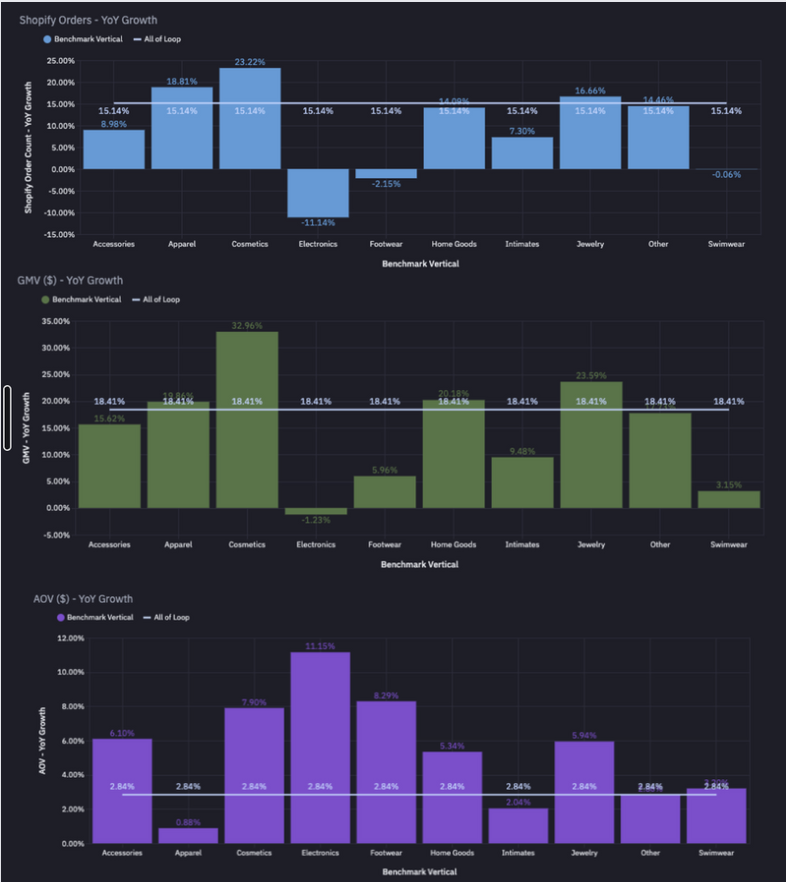As expected, Black Friday Cyber Monday (BFCM) this year was a banger, with Shopify reporting a record-breaking $9.3 billion in sales over the busy ecommerce weekend. Loop’s merchants alone made $1.3 billion themselves—a 18% increase over last year—which means we’re certainly celebrating!
But aside from raw sales numbers alone, the data our team at Loop pulled reveals some rather interesting info about the doorbusting weekend.
Let’s get into it.
Increases in average order value, GMV, and growth YoY
Overall, Loop’s merchants saw significant year over year (YoY) growth in sales. As we mentioned before, Loop’s merchants alone generated over $1.32 billion in GMV. That means our merchants overall saw an 18% increase YoY in Shopify sales.
Enterprise merchants in particular had an impressive BFCM, with nearly 20% GMV growth YoY. They outperformed the Mid-market and SMB segments in both orders and GMV. That doesn’t mean that small businesses suffered, though. Loop’s SMB merchants saw higher average order value (AOVs) YoY than larger merchants did.
Enterprise merchants:
Shopify Orders: +16.9%
GMV ($): +19.6%
AOV ($): +2.3%
Mid-market merchants:
Shopify Orders: +11.7%
GMV ($): +16.4%
AOV ($): +4.3%
SMB merchants:
Shopify Orders: +9%
GMV ($): +15.8%
AOV ($): +6.3%
Black Friday reigns supreme
While sales were up all weekend (clearly), certain days saw more action than others. In keeping with what we’ve seen in previous years, Black Friday came out on top, with 3.9 million Shopify orders placed on that day, for a total GMV of $485.6 million and an average order value of $125.
Here’s the breakdown:
Black Friday:
Shopify Orders: 3.9M (+13.9% YoY)
GMV ($): $485.6M (+18.68% YoY)
AOV ($): $125 (+4.2% YoY)
Saturday:
Shopify Orders: 2.0M (+20.0% YoY)
GMV ($): $242.5M (+21.31% YoY)
AOV ($): $120 (+1.1% YoY)
Sunday:
Shopify Orders: 1.9M (+16.3% YoY)
GMV ($): $234.3M (+19.0%% YoY)
AOV ($): $122 (+2.4% YoY)
Cyber Monday:
Shopify Orders: 3.0M (+10.6% YoY)
GMV ($): $234.3M (+13.9% YoY)
AOV ($): $120 (+3.0% YoY)
As you can see above, Black Friday was the main daily driver in the increase of orders and GMV, followed by Cyber Monday. As expected, both Saturday and Sunday had fewer orders and associated GMV. However, surprisingly, those two days had the highest YoY growth in both order volume and GMV. This could be an indication that Black Friday discounts and promotions continued throughout the weekend, which relieved the pressure of buying only on Black Friday and Cyber Monday.
Cosmetics and jewelry brands were the big winners by vertical
Nearly all benchmark verticals saw increase YoY sales volume and GMV. However, there were some verticals that did better than others.

This year during BFCM weekend, Cosmetics and Jewelry brands saw the highest growth in GMV (33% and 23.6%, respectively). On the other hand, Electronics and Footwear companies had a harder time (-1.2% and 5% in YoY GMV growth, respectively). It is interesting to note that for Footwear, the orders are only up 6%, but AOV is up over 8%. This might mean that shoppers were ordering more than one size of the same shoe in order to see which size fit better, with the intention to return the one that didn’t fit as well. In the returns space, this behavior is called bracketing, and you can learn more about it here.
Still, most verticals saw a lot of good growth and sales, which is really wonderful to see.
Who bought more? New shoppers or returning shoppers?
Brands often look at BFCM as a chance to entice new shoppers to check out their brand. This year, we wanted to answer a burning question we had: Who spent more with Loop brands, new shoppers or returning shoppers?
New Shoppers:
Shopify Orders: +12.4% YoY
GMV ($): +14.5% YoY
AOV ($): +1.84% YoY
Returning Shoppers:
Shopify Orders: +18.2% YoY
GMV ($): +23.0% YoY
AOV ($): +4.0% YoY
When looking at new shopper activity compared to returning shopper activity, we see that returning shoppers have outperformed new shoppers from BFCM 2022 and BFCM 2023 in all of the metrics above. This stresses the importance of retaining customers, but also shows that acquiring new shoppers helps with the overall sales performance.
In short, it’s important to help new shoppers find your brand, but also to make sure that you keep your current shoppers happy. A great way to do that? Provide a killer returns experience. After all, 93% of consumers agree that retailers with flexible return policies care more about them as a customer, and 57% of shoppers are willing to abandon a brand entirely when provided a poor post-purchase experience. Make sure that your returns don’t tank your BFCM progress—keep your returns easy and shopper-friendly, and you’ll see loyal customers return to shop with your brand again and again (Black Friday or not!).
Worried about managing returns this holiday season? Loop has you covered. Book a demo today.

